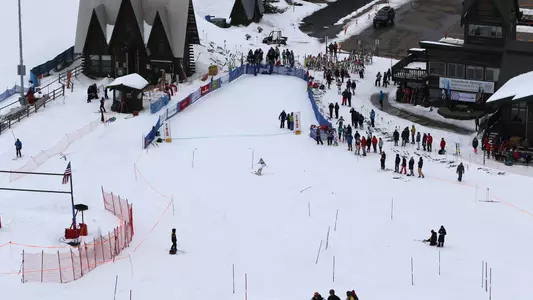Colorado University Athletics

Skiing 101
March 01, 2018 | Skiing
Of the 24 NCAA-sanctioned sports there are few that attract as many puzzled looks and questions as ski racing. Let us help educate you on the sport CU has won 20 national championships in.
BOULDER — Of the 24 NCAA-sanctioned sports there are few that attract as many puzzled looks and questions as ski racing.
This could be partially due to the fact that the sport combines two very different types of skiing and has both genders competing for the same national title, but it also stems from the fact the sport may be unfamiliar to the "average" viewer.
Today we will try to demystify the sport of skiing with a crash course into the rules and competitive format of skiing.
ALPINE
Alpine is one of the two forms of skiing that make up NCAA competition. In the simplest of terms, alpine skiers go downhill and Nordic skiers go uphill.
Within alpine skiing, there are two disciplines in which athletes compete, slalom and giant slalom. Slalom is the event in which there is a single gate and the athletes make shorter radius turns. This is also the event in which athletes "block" the gates with their hands and are commonly asked by outside viewers if that hurts or not (people usually do not feel the gates since they have pads on).
The second discipline, giant slalom, has two gates with a panel in between them and the turns are a larger radius than slalom, increasing the speed of this event. Rather than blocking the gates, racers brush them with their shoulders.
Many people ask why racers hit the gates or if there is a penalty for not touching them. The reason racers hit the gates is because they are trying to take the shortest line from the start to the finish and by skiing as close to the gates as possible they minimize the distance they travel and reduces their time. The only way ski racers are penalized is if they do not travel around every gate, in which case they are disqualified.
Alpine events are raced in a two-run combined-time format and the course is reset between runs, so times from the first and second run cannot be directly compared. Combined times are usually between 2 minutes to 2:30 for a racer, depending on the hill and the course set.
In both disciplines, the two run format is used and during the first run racers start with the highest ranked skiers going first. .
For the second run, the results of the first run are inversed for the top 30 and the fastest skiers are put at a disadvantage in what is called "the flip".
NORDIC
Compared to alpine, Nordic skiing plays out over a longer period of time and is also broken down into two distinct disciplines: classic and skate (officially know as freestyle).
Course distances range from 5K to 20K, with athletes spending as little as 15 minutes to over an hour on course. Races can also be broken down into interval and mass starts, with mass starts being reserved for the longer races so there is more room for a tactical approach.
When breaking down the two disciplines, the main difference is the technique the athlete uses on course.
In its most basic form, classic competitors use longer skis and a shorter pole length. Skiers must stay inside the tracks using the "kick and glide" technique and are not allowed to push laterally.
In skate, athletes use longer poles and are allowed to push their legs similar to a hockey player, thus using lateral force and their arms at the same time.
Although these differences seem subtle to the outside observer they can be a world of difference to athletes whose technique is greater in one discipline over the other. Nordic skiers also frequently mention that they are asked whether they are cold in their suits or not. The verdict I received from many Nordic skiers is that yes they are indeed rather cold.
SCORING FORMAT
The latest scoring format was adopted in 2014, where a maximum 30 skiers can score for their teams. The weighted 40-point base still rewards the top eight skiers in the field with varying additional points over the skier behind them.
Scoring is as follows: 40-37-34-31-29-27-25-23-22-21-20-19-18-17-16-15-14-13-12-11-10-9-8-7-6-5-4-3-2-1; the west has used this format the last three years, the east still uses the old 50-point format that allowed 39 skiers to score for their teams.
Unlike from 1997-2009, no scores are thrown out for those teams that qualified a full 12-skier team or one shy with 11; so to tabulate the final standings, all scores have counted since 2010.
Now that you have your entry-level knowledge in the sport of ski racing, make plans to attend the March 7-10 NCAA Championships in Steamboat Springs and cheer on your Buffs as they chase their 21st NCAA title on their home snow.
This could be partially due to the fact that the sport combines two very different types of skiing and has both genders competing for the same national title, but it also stems from the fact the sport may be unfamiliar to the "average" viewer.
Today we will try to demystify the sport of skiing with a crash course into the rules and competitive format of skiing.
ALPINE
Alpine is one of the two forms of skiing that make up NCAA competition. In the simplest of terms, alpine skiers go downhill and Nordic skiers go uphill.
Within alpine skiing, there are two disciplines in which athletes compete, slalom and giant slalom. Slalom is the event in which there is a single gate and the athletes make shorter radius turns. This is also the event in which athletes "block" the gates with their hands and are commonly asked by outside viewers if that hurts or not (people usually do not feel the gates since they have pads on).
The second discipline, giant slalom, has two gates with a panel in between them and the turns are a larger radius than slalom, increasing the speed of this event. Rather than blocking the gates, racers brush them with their shoulders.
Many people ask why racers hit the gates or if there is a penalty for not touching them. The reason racers hit the gates is because they are trying to take the shortest line from the start to the finish and by skiing as close to the gates as possible they minimize the distance they travel and reduces their time. The only way ski racers are penalized is if they do not travel around every gate, in which case they are disqualified.
Alpine events are raced in a two-run combined-time format and the course is reset between runs, so times from the first and second run cannot be directly compared. Combined times are usually between 2 minutes to 2:30 for a racer, depending on the hill and the course set.
In both disciplines, the two run format is used and during the first run racers start with the highest ranked skiers going first. .
For the second run, the results of the first run are inversed for the top 30 and the fastest skiers are put at a disadvantage in what is called "the flip".
NORDIC
Compared to alpine, Nordic skiing plays out over a longer period of time and is also broken down into two distinct disciplines: classic and skate (officially know as freestyle).
Course distances range from 5K to 20K, with athletes spending as little as 15 minutes to over an hour on course. Races can also be broken down into interval and mass starts, with mass starts being reserved for the longer races so there is more room for a tactical approach.
When breaking down the two disciplines, the main difference is the technique the athlete uses on course.
In its most basic form, classic competitors use longer skis and a shorter pole length. Skiers must stay inside the tracks using the "kick and glide" technique and are not allowed to push laterally.
In skate, athletes use longer poles and are allowed to push their legs similar to a hockey player, thus using lateral force and their arms at the same time.
Although these differences seem subtle to the outside observer they can be a world of difference to athletes whose technique is greater in one discipline over the other. Nordic skiers also frequently mention that they are asked whether they are cold in their suits or not. The verdict I received from many Nordic skiers is that yes they are indeed rather cold.
SCORING FORMAT
The latest scoring format was adopted in 2014, where a maximum 30 skiers can score for their teams. The weighted 40-point base still rewards the top eight skiers in the field with varying additional points over the skier behind them.
Scoring is as follows: 40-37-34-31-29-27-25-23-22-21-20-19-18-17-16-15-14-13-12-11-10-9-8-7-6-5-4-3-2-1; the west has used this format the last three years, the east still uses the old 50-point format that allowed 39 skiers to score for their teams.
Unlike from 1997-2009, no scores are thrown out for those teams that qualified a full 12-skier team or one shy with 11; so to tabulate the final standings, all scores have counted since 2010.
Now that you have your entry-level knowledge in the sport of ski racing, make plans to attend the March 7-10 NCAA Championships in Steamboat Springs and cheer on your Buffs as they chase their 21st NCAA title on their home snow.
Colorado Ski: Why CU?
Friday, June 27
Colorado Ski: 2025 Facility Tour
Tuesday, June 10
Colorado Ski: 2024-25 Banquet
Tuesday, April 22
2024 Ski Team Season Recap
Tuesday, April 30





